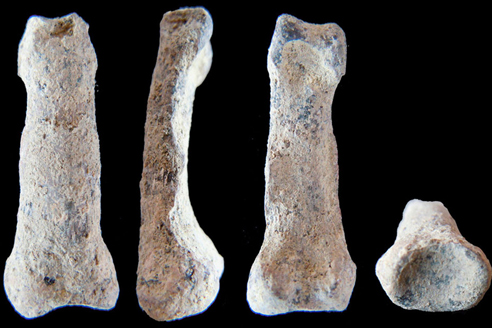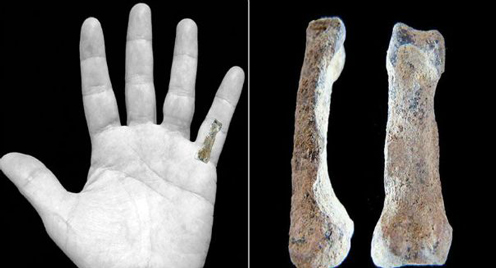Ancestors May Have Come Down From the Trees Earlier than Thought
A tiny, little finger bone, representing the proximal phalanx of the fifth digit of a hominin’s left hand has led scientists to reconsider the date of our ancestor’s descent from the trees. Put simply, the discovery of one of the world’s oldest little finger bones from a human-like species suggests that at around 1.8 million years ago hands had already become much more readily adapted to using tools than to climbing trees. The finger bone, is not curved, curved bones in the digits are indicative of a grasping, weight bearing role very typical of apes that live in trees. The bone is very similar in shape to that of a modern human little finger bone (Homo sapiens).
Various Views of the Little Finger Bone (Proximal Phalanx)
Picture credit: M. Domínguez-Rodrigo
Little Finger Bone from Olduvai Gorge
The bone was discovered in the Olduvai Gorge region of Tanzania and it is estimated to be about 1.8 million years old. The fossil find suggests that by 1.8 million years ago, a human-like species had already made the transition to terrestrial living whilst co-existing with more arboreal hominins such as Homo habilis and a member of a distantly related sub-branch to the hominin family tree that led to modern humans Paranthropus boisei.
From the Trees to the Ground
According to researchers such as Manuel Domínguez-Rodrigo (co-director of the Olduvai Gorge-based project The Institute of Evolution in Africa), this discovery pushes back the origin of dextrous human digits some 400,000 years.
Commenting on the fossil find, Manuel Domínguez-Rodrigo, one of the team members who analysed the bone stated:
“This bone belongs to somebody who’s not spending any time in the trees at all. Hanging from branches tends to bend bones like this one that extend from the knuckle, whereas in modern humans, and in this case they are straighter.”
The Position of the Fossil Proximal Phalanx in a Modern Human Left Hand
Picture credit: M. Domínguez-Rodrigo
Evidence Supporting a Change of Behaviour in Ancient Ancestors
The scientist, who has been involved in research projects in Tanzania since 2006 explained that this was evidence supporting a significant change in the behaviour of our ancient ancestors. If the hands were no longer being used to climb trees, then they could be being used for other purposes such as making tools.
Biological anthropologist Brian Richmond (American Museum of Natural History, New York) and another specialist in early human history commented:
“This provides good evidence supporting the hypothesis that, by about two million years ago, our early ancestors lost the anatomy linked to our tree-climbing past.”
Although the finger bone is a different shape from the bones of contemporary Australopithecines, other scientists, such as Richard Potts of the Smithsonian Human Origins Programme (Washington D.C.) has suggested that a single bone is not enough evidence to conclude that the hand it came from truly resembles that of a modern human ancestor.
Everything Dinosaur stocks a range of early hominin models and figures: Wild Safari Prehistoric World Hominins and Prehistoric Animals.







